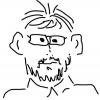
shojtsy
-
Posts
194 -
Joined
-
Last visited
Reputation Activity
-
 shojtsy got a reaction from Chris B in 1.8.0.555 Layer panel is lazy for text objects
shojtsy got a reaction from Chris B in 1.8.0.555 Layer panel is lazy for text objects
When creating an "Art Text" layer panel shows text content as well for each of the texts. The updating of this panel is incorrect. After typing a text fast and waiting, the layer name in the layer panel keeps showing some earlier state of the text content. When clicking away in the layer panel to another layer, the name is suddenly updated. My expected behavior is that the layer panel keeps up to date with text content, or fixes itself after some short user idle time.
-
 shojtsy got a reaction from Gunny in Add support for Mask to Below in Macros
shojtsy got a reaction from Gunny in Add support for Mask to Below in Macros
Hi,
In the right-click context menu on layers there is a Mask to Below which doesn't seem to be accessible from the main menu. Since the right-click menu is disabled while recording Macros, it means that this function can not be recorded in Macros, however It would be really useful.
Please add a way to run this command during Macro recording and have it recorded.
As a separate request please make it possible to assign a hotkey to the "Mask to Below" function.
-
 shojtsy got a reaction from IPv6 in Using channel mixer for masks
shojtsy got a reaction from IPv6 in Using channel mixer for masks
There is a repeating wish that people would like to use the full scale of editing tools on masks, and handle them as grayscale layers. They are usually told that masks only have the alpha channel, and they are mistaken to think that values of alpha are considered shades of gray.
I think this is not the full story. One can use a regular pixel layer as mask, and the alpha channel (transparency) of the pixel layer will be used for masking, while ignoring the RGB channels of it. Furthermore it is possible to put a live Channel mixer adjustment on top of a pixel layer which makes it transparent based on it's luminosity. Combine these two tricks, you get a mask, where you can do every aspect of grayscale editing.
Here are the steps:
You have pixel layer A you would like to mask, and pixel layer M you would like to use as mask. You nest a Channel Mixer adjustment inside M, choose LAB channels, Alpha channel, make contribution of input Alpha 0, and contribution of input Lightness 100% into Alpha. Layer M should be above layer A. Right-click layer M, and choose Mask to Below. Bam, you have a mask pixel layer to do any edits and it's luminosity is used for masking. (beware of a GUI limitation that nested children of masks are not shown on the layers panel)
What do you think?
-
 shojtsy reacted to Eric5 in displace filter additions
shojtsy reacted to Eric5 in displace filter additions
Would be nice to have adjustable x and y sizes for displacement map as well as what to do with extra or not enough pixels (wrap around, etc).
-
 shojtsy reacted to jc4d in Layer Color Label
shojtsy reacted to jc4d in Layer Color Label
Hi all,
Would be nice to be able to add color label to layers for organizational purposes, when dealing with +50 layers and groups, having them categorized by colors would make it easier to navigate in the Layers panel.
If this feature is added, please allow the users to choose any color and not limited by few presets only.
Cheers,
Juan
-
 shojtsy reacted to LenC in LAB color space and user interface issue
shojtsy reacted to LenC in LAB color space and user interface issue
I am a beginner in LAB attempting to apply the writings of Dan Margulis, who uses only Photoshop, to Affinity Photo. The LAB underlying functionality is mostly OK, but I have found that the AP user interface could be improved in several places. More experienced users, please comment.
1) In the Curves adjustment layer with LAB selected, the A channel curve is colored green and the B curve magenta. The appropriate colors are green left and magenta right for A; blue left and yellow right for B (with light or high luminosity on the right).
2) Creating a check box on the A and B curve windows for Intersect Midpoint would make it easier to construct color-intensifying curves. This is probably the most important basic move in LAB, and even Photoshop does not have this feature.
3) The Input Minimum and Maximum default to 0 and 1. Though I have not found a use for these, shouldn’t they be -1 to 1 or -100 to 100 or -127 to 127?
4) The Curves/LAB window’s second drop-down menu offers Master, L, A, B, and alpha. Is there a known use for ‘Master’ as in RGB? Nothing I have read about LAB indicates that there is. For that matter, is there any use for Master in CMYK? And how about ‘All’ as an alternative to Master in RGB? Furthermore, the histogram curves displayed for the LAB components here are not positioned the same as when one transforms the document to LAB and displays its histograms. May relate to previous point (3).
5) Photoshop can display the graphs of the various color space curves with the light (high-luminosity) side on the right or left (one-click toggle). This option would be useful to people learning from Margulis’s books, which show dark on the right.
6) Other Affinity users have called for improvements in the Curves window in general, not just for LAB: more precision and ways of placing nodes, a larger or scalable window, saving curves. Because of the sensitivity of the A and B curves to small movements, a fine control on node dragging would be handy, e.g., option-drag would reduce the motion by 1/5 or 1/10. Perhaps it already exists.
7) A LAB curves user on this forum called for a keyboard shortcut to move among the channels. Why not? He needs efficiency in a much-used workflow application. In the same vein, having selected the color space, instead of a second drop-down, radio buttons for the three or four channels would slightly simplify choosing one.
8) In the Channel Mixer adjustment layer, the LAB window A and B sliders need appropriate coloring like the RGB and CMYK. Just for consistency.
9) The Levels adjustment layer makes sense in RGB, but I am not so sure about LAB and CMYK. Does this lead to a useful correction? (Please help me, advanced users.) If you push the existing RGB colors to the AB limits of +/-127 won’t you just create out-of-gamut colors that will have to be distorted back in RGB space? And is gamma defined for this color space? Also, in the LAB window, shouldn’t the correct labels for the sliders be, for the A channel, green and magenta, and for the B, blue and yellow. Similar questions for CMYK.
10) The Apply Image filter and Channel Mixer adjustment layer seem as if they should have similar functionality, but their capabilities and interfaces are rather different. My understanding of Apply Image in Photoshop from Margulis is to blend or replace channels one at a time, sometimes across color spaces, but to do that in AP one has to create a gray scale image of a channel in a layer and make that the source. The destination seems to be all channels of a selected layer, or does one have to separate out those channels as well? The Channel Mixer is designed to specify a single channel as destination, but it appears the source must be in the same color space. Shouldn’t these two processes allow individual choice of source and destination channels in all color spaces? Are equations (Apply Image) and sliders (Channel Mixer) of equal value in practical applications?
I don’t think this exhausts these issues, but this post has already exhausted me. My compliments if you have read this far. If you want to know more about Margulis, use a search engine or post here and I will try to summarize what I have earned from a large corpus of writing.
-
 shojtsy reacted to Uncle Mez in Affinity Photo: Non Destructive Operations
shojtsy reacted to Uncle Mez in Affinity Photo: Non Destructive Operations
Hello Everyone !
Would ask for more Non-Destructive capabilities to be added to Affinity Photo.
There are great initiative taken with certain tools using a blank pixel layer but i believe more needs to be implemented and documented.
i'm first thinking about :
The Tone Mapping Persona: this is a great place for making our work better but it's only works in a destructive way (maybe i don't how to do it) but it would be great if a tone map can be added to a mask or a blank pixel layer then we can chose from there to map only a certain area/object etc of our photo/picture/
Development Persona: Great place to spend time working on better picture but also everything there is destructive, here i propose that one applied, our development to appears on sub or top layers similar to filter or mask or whatever dev's may find then from there we can mask this or that or simply make it possible continue where we left it in case we click the development persona again.
Same thing should be applied to Liquify persona too.
in fact, more Non-Destructive is okay and will be well received.
if anyone knows how to do deep Non-Destructive works and/or know where to find tutos that talks about, please share !
Blessings !
-
 shojtsy got a reaction from PaulAffinity in Delete layer group issue 1.7.0.188
shojtsy got a reaction from PaulAffinity in Delete layer group issue 1.7.0.188
Please see below the same done with 1.7.0.188.
I have tried the Clear User Data advised by MEB, but it does not solve this.
-
 shojtsy got a reaction from Rondo in Using channel mixer for masks
shojtsy got a reaction from Rondo in Using channel mixer for masks
There is a repeating wish that people would like to use the full scale of editing tools on masks, and handle them as grayscale layers. They are usually told that masks only have the alpha channel, and they are mistaken to think that values of alpha are considered shades of gray.
I think this is not the full story. One can use a regular pixel layer as mask, and the alpha channel (transparency) of the pixel layer will be used for masking, while ignoring the RGB channels of it. Furthermore it is possible to put a live Channel mixer adjustment on top of a pixel layer which makes it transparent based on it's luminosity. Combine these two tricks, you get a mask, where you can do every aspect of grayscale editing.
Here are the steps:
You have pixel layer A you would like to mask, and pixel layer M you would like to use as mask. You nest a Channel Mixer adjustment inside M, choose LAB channels, Alpha channel, make contribution of input Alpha 0, and contribution of input Lightness 100% into Alpha. Layer M should be above layer A. Right-click layer M, and choose Mask to Below. Bam, you have a mask pixel layer to do any edits and it's luminosity is used for masking. (beware of a GUI limitation that nested children of masks are not shown on the layers panel)
What do you think?
-
 shojtsy got a reaction from Fotoloco in Add support for Mask to Below in Macros
shojtsy got a reaction from Fotoloco in Add support for Mask to Below in Macros
I would actually like to record making a pixel layer or even a layer group into a mask, not by Rasterize to Mask, but in the same way as dragging it into the mask position. Assistant doesn't help with this. All that would be needed is a menu item in Arrange menu, same as Mask to Below. Pretty minor request in my opinion.
-
 shojtsy got a reaction from Fotoloco in Add support for Mask to Below in Macros
shojtsy got a reaction from Fotoloco in Add support for Mask to Below in Macros
Hi,
In the right-click context menu on layers there is a Mask to Below which doesn't seem to be accessible from the main menu. Since the right-click menu is disabled while recording Macros, it means that this function can not be recorded in Macros, however It would be really useful.
Please add a way to run this command during Macro recording and have it recorded.
As a separate request please make it possible to assign a hotkey to the "Mask to Below" function.
-
 shojtsy got a reaction from dmstraker in Reflect Blend Mode
shojtsy got a reaction from dmstraker in Reflect Blend Mode
For the photoshop ones yes. For example this is quite good http://photoblogstop.com/photoshop/photoshop-blend-modes-explained (but still not explain how Fill Opacity is used in the blending formula)
However for the Serif - introduced blend modes, they won't be found in these sites.
Edit: Your links lead me to this site which document the blend mode formulas of Pegtop, among them Reflect and Glow.
http://www.pegtop.net/delphi/articles/blendmodes/quadratic.htm
I have tested that they match the behavior of Affinity.
-
 shojtsy reacted to pixelworker in mouse wheel Zoom is almost useless - integer steps (100%, 200%) MUST be part of the possible steps
shojtsy reacted to pixelworker in mouse wheel Zoom is almost useless - integer steps (100%, 200%) MUST be part of the possible steps
I really dislike the mouse zoom in affinity. It's a constant pita for me. Why? It doesn't hit the important integer steps 100%, 200%, 300%, but values like 102%, 313%.
So it's not possible to zoom to a state where you don't have scaling issues on 1px lines.
I need to use shortcuts for this or click in the UI on the -+ buttons in the navigator. But I really like moue wheel zoom because it's so natual and fast and I don't need to move my hand on the keyboard as much when I don't need to constantly hit shortcuts JUST for zooming to get a integer zoom factor.
Need: Please provide a mouse wheel zoom which has steps at all important values (100%, 200%, 300%....800%...).
-
 shojtsy reacted to Felonius in ONE MORE TIME: Hold SHIFT to constrain to 45/90/180 angles in AF Photo using brush and erase tools
shojtsy reacted to Felonius in ONE MORE TIME: Hold SHIFT to constrain to 45/90/180 angles in AF Photo using brush and erase tools
The lack of this feature remains a continuing annoyance every time I use AF Photo. It's been in Photoshop for as long as I can remember, since at least Photoshop 7, waaaaaay back in 2002.
Not having this feature is particularly troublesome when I want to use a square brush with the erase tool to trim off corners in at perfect 90 degree angles, or when I want to do a perfectly straight-line clone stamp or brush stroke.
Please add this feature. Thing is, it's already in place for the pen tool in AF Photo right now ---- click to drop a node, hold SHIFT to constrain a straight line angle before dropping your next node. It can't be that much more work to add it for the brush, clone stamp, and erase tools.
-
 shojtsy got a reaction from Stuart_James in Add icon to indicate presence of blend options
shojtsy got a reaction from Stuart_James in Add icon to indicate presence of blend options
When you add layer effects to layer they are indicated in the layer panel with an "fx" icon next to the layer. However if you modify the blend ranges for a layer they are not indicated in any way, and the presence of the blend range setting is only visible if you know to open the blend options cog icon. With many layers this can become confusing. Please add a cog icon next to the layer in a similar fashion as the fx icon when the blend range options are not on the default setting to indicate their presence.
-
 shojtsy got a reaction from Roger C in Add icon to indicate presence of blend options
shojtsy got a reaction from Roger C in Add icon to indicate presence of blend options
When you add layer effects to layer they are indicated in the layer panel with an "fx" icon next to the layer. However if you modify the blend ranges for a layer they are not indicated in any way, and the presence of the blend range setting is only visible if you know to open the blend options cog icon. With many layers this can become confusing. Please add a cog icon next to the layer in a similar fashion as the fx icon when the blend range options are not on the default setting to indicate their presence.
-
 shojtsy got a reaction from Fixx in Add icon to indicate presence of blend options
shojtsy got a reaction from Fixx in Add icon to indicate presence of blend options
When you add layer effects to layer they are indicated in the layer panel with an "fx" icon next to the layer. However if you modify the blend ranges for a layer they are not indicated in any way, and the presence of the blend range setting is only visible if you know to open the blend options cog icon. With many layers this can become confusing. Please add a cog icon next to the layer in a similar fashion as the fx icon when the blend range options are not on the default setting to indicate their presence.
-
 shojtsy got a reaction from Alfred in Add icon to indicate presence of blend options
shojtsy got a reaction from Alfred in Add icon to indicate presence of blend options
When you add layer effects to layer they are indicated in the layer panel with an "fx" icon next to the layer. However if you modify the blend ranges for a layer they are not indicated in any way, and the presence of the blend range setting is only visible if you know to open the blend options cog icon. With many layers this can become confusing. Please add a cog icon next to the layer in a similar fashion as the fx icon when the blend range options are not on the default setting to indicate their presence.
-
 shojtsy got a reaction from fannypack in Add icon to indicate presence of blend options
shojtsy got a reaction from fannypack in Add icon to indicate presence of blend options
When you add layer effects to layer they are indicated in the layer panel with an "fx" icon next to the layer. However if you modify the blend ranges for a layer they are not indicated in any way, and the presence of the blend range setting is only visible if you know to open the blend options cog icon. With many layers this can become confusing. Please add a cog icon next to the layer in a similar fashion as the fx icon when the blend range options are not on the default setting to indicate their presence.
-
 shojtsy got a reaction from lepr in Add icon to indicate presence of blend options
shojtsy got a reaction from lepr in Add icon to indicate presence of blend options
When you add layer effects to layer they are indicated in the layer panel with an "fx" icon next to the layer. However if you modify the blend ranges for a layer they are not indicated in any way, and the presence of the blend range setting is only visible if you know to open the blend options cog icon. With many layers this can become confusing. Please add a cog icon next to the layer in a similar fashion as the fx icon when the blend range options are not on the default setting to indicate their presence.
-
 shojtsy got a reaction from kaffeeundsalz in Add icon to indicate presence of blend options
shojtsy got a reaction from kaffeeundsalz in Add icon to indicate presence of blend options
When you add layer effects to layer they are indicated in the layer panel with an "fx" icon next to the layer. However if you modify the blend ranges for a layer they are not indicated in any way, and the presence of the blend range setting is only visible if you know to open the blend options cog icon. With many layers this can become confusing. Please add a cog icon next to the layer in a similar fashion as the fx icon when the blend range options are not on the default setting to indicate their presence.
-
 shojtsy reacted to Publoo in Perspective Grid
shojtsy reacted to Publoo in Perspective Grid
Hello Affinity.
I would like to propose a new document grid. Is there a chance to add a perspective grid, making it easier to create drawings using perspective? This grid was introduced in ArtRage 5 and it is very useful.
For now, I created this grid by hand: Designia_Perspective_Grid.afassets
Best Regards
-
 shojtsy reacted to JLGF1 in File-open status bar request
shojtsy reacted to JLGF1 in File-open status bar request
Pretty please...could the devs implement a file-open status bar (like the file-close) like pretty much every other app on the planet?
When exporting large DNG's from other apps into AP one is left wondering if anything is going on.
Thanks!
-
 shojtsy reacted to Flocki24 in Layer panel icon size is too small
shojtsy reacted to Flocki24 in Layer panel icon size is too small
I work with a 22-inch display, but i wish a option to make the iconsize in the layer panel greater.
Thank
Armin
-
 shojtsy reacted to Heres Johnny in Designer & Photo | Release layer effects
shojtsy reacted to Heres Johnny in Designer & Photo | Release layer effects
Like in Photoshop - render layer effects (like Outer Shadow) to a seperate raster/pixel layer.






